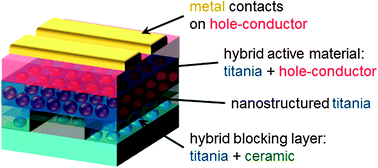Nanostructured titania films are of growing interest due to their application in future photovoltaic technologies. Therefore, a lot of effort has been put into the controlled fabrication and tailoring of titania nanostructures. The controlled sol–gel synthesis of titania, in particular in combination with block copolymer templates, is very promising because of its high control on the nanostructure, easy application and cheap processing possibilities. This tutorial review gives a short overview of the structural control of titania films gained by using templated sol–gel chemistry and shows how this approach is extended by the addition of further functionality to the films. Different expansions of the sol–gel templating are possible by the fabrication of gradient samples, by the addition of a homopolymer, by the combination with micro-fluidics and also by the application of novel precursors for low-temperature processing. Moreover, hierarchically structured titania films can be fabricated via the subsequent application of several sol–gel steps or via the inclusion of colloidal templates in a one-step process. Integrated function in the block copolymer used in the sol–gel synthesis allows for the fabrication of an integrated blocking layer or an integrated hole-conductor. Both approaches grant a one-step fabrication of two components of a working solar cell, which make them very promising towards a cheap solar cell production route. Looking to the complete solar cell, the top contact is also of great importance as it influences the function of the whole solar cell. Thus, the mechanisms acting in the top contact formation are also reviewed. For all these aspects, characterization techniques that allow for a structural investigation of nanostructures inside the active layers are important. Therefore, the characterization techniques that are used in real space as well as in reciprocal space are explained shortly as well.

You have access to this article
 Please wait while we load your content...
Something went wrong. Try again?
Please wait while we load your content...
Something went wrong. Try again?


 Please wait while we load your content...
Please wait while we load your content...